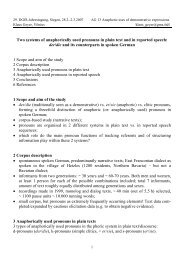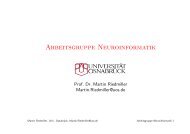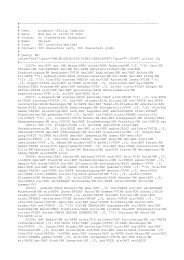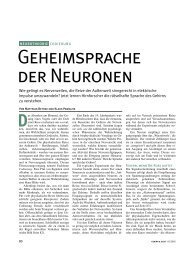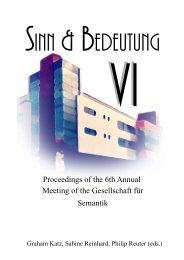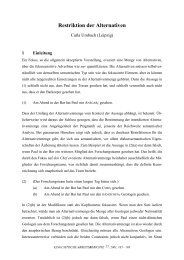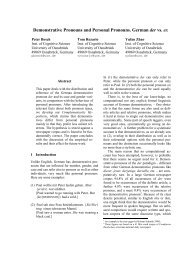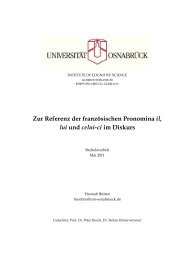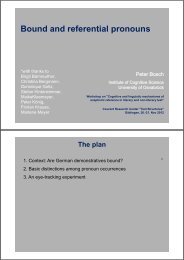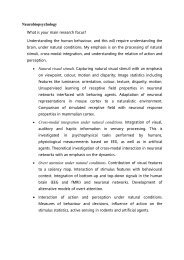Robert C. Stalnaker: Assertion
Robert C. Stalnaker: Assertion
Robert C. Stalnaker: Assertion
Create successful ePaper yourself
Turn your PDF publications into a flip-book with our unique Google optimized e-Paper software.
Graham Katz, Introduction to Semantics SS03<br />
University of Osnabrück<br />
<strong>Robert</strong> C. <strong>Stalnaker</strong>: <strong>Assertion</strong><br />
by Jan Scholz
Part I: Semantics & Modal<br />
Logic
<strong>Robert</strong> C. <strong>Stalnaker</strong>: <strong>Assertion</strong> 3<br />
<strong>Assertion</strong>s (Behauptungen)<br />
• have a content (propositions)<br />
• are made in a context<br />
• content depends on the context<br />
• acts of assertion affect the context
Questions<br />
<strong>Robert</strong> C. <strong>Stalnaker</strong>: <strong>Assertion</strong> 4<br />
• How do content and context interact?<br />
• How do assertions act on the context in<br />
which they are made?
Proposition<br />
<strong>Robert</strong> C. <strong>Stalnaker</strong>: <strong>Assertion</strong> 5<br />
• is a function from possible worlds into<br />
truth values<br />
• and thereby determines a set of<br />
possible worlds: W = { w | φ is true in w}
Possible Worlds<br />
<strong>Robert</strong> C. <strong>Stalnaker</strong>: <strong>Assertion</strong> 6<br />
• ~ distinction among alternative ways<br />
that things might be, or might have<br />
been<br />
• every set of possible worlds determines<br />
the proposition φ, which is true for every<br />
w ∈ W.<br />
• Note: If several propositions fullfill this constraint,<br />
they are the same.
<strong>Robert</strong> C. <strong>Stalnaker</strong>: <strong>Assertion</strong> 7<br />
⇒ one-one correspondence between sets<br />
of possible worlds and propositions
<strong>Robert</strong> C. <strong>Stalnaker</strong>: <strong>Assertion</strong> 8<br />
Two-Dimensional Modal Logic<br />
We might represent a proposition by enumerating the<br />
truth values that it has in the different possible worlds<br />
i, j, k.<br />
A<br />
i<br />
T<br />
j<br />
F<br />
k<br />
T<br />
different<br />
possible sets<br />
of facts that<br />
determin the<br />
truth value of<br />
the proposition
<strong>Robert</strong> C. <strong>Stalnaker</strong>: <strong>Assertion</strong> 9<br />
Two-Dimensional Modal Logic<br />
There is a second way that the facts enter into the<br />
determination of the truth value. They can affect the<br />
proposition, too.<br />
imaging the following situation...
name<br />
I<br />
O‘Leary<br />
Daniels<br />
facts<br />
fool(O‘Leary)<br />
¬ fool(Daniels)<br />
¬ fool(O‘Leary)<br />
fool(Daniels)<br />
fool(O‘Leary)<br />
¬ fool(Daniels)<br />
Accusations<br />
(what the person believes)<br />
utterance<br />
fool(O‘Leary)<br />
fool(O‘Leary)<br />
fool(Daniels)<br />
<strong>Robert</strong> C. <strong>Stalnaker</strong>: <strong>Assertion</strong> 10<br />
utterance‘s<br />
truth value<br />
T<br />
F<br />
F
<strong>Robert</strong> C. <strong>Stalnaker</strong>: <strong>Assertion</strong> 11<br />
2D Modal Logic: Matrix<br />
• the vertical axis represents possible worlds in their<br />
role as context – as what determines what is said<br />
• the horizontal axis represent possible worlds in their<br />
role as the arguments of the functions which are the<br />
propositions expressed<br />
utterances<br />
B<br />
i<br />
j<br />
k<br />
possible worlds<br />
i<br />
T<br />
T<br />
F<br />
j<br />
F<br />
F<br />
T<br />
k<br />
T<br />
T<br />
F
<strong>Robert</strong> C. <strong>Stalnaker</strong>: <strong>Assertion</strong> 12<br />
Diagonal Proposition<br />
• is the proposition that is true at l for any l iff what is<br />
expressed in the utterance at l is true at l.<br />
B<br />
i<br />
j<br />
k<br />
i<br />
T<br />
T<br />
F<br />
j<br />
F<br />
F<br />
T<br />
k<br />
T<br />
T<br />
F
<strong>Robert</strong> C. <strong>Stalnaker</strong>: <strong>Assertion</strong> 13<br />
Propositional Concept<br />
• We will call what a matrix like B represents a<br />
propositional concept<br />
• A propositional concept is a function from possible<br />
worlds into propositions<br />
• or a function from an ordered pair of possible worlds<br />
into a truth value (remember the definition of a<br />
proposition)
Operator<br />
~<br />
,<br />
†, †<br />
Modal Operators<br />
Name<br />
existential negation<br />
operator<br />
possibility, necessity<br />
dagger, square-dagger<br />
<strong>Robert</strong> C. <strong>Stalnaker</strong>: <strong>Assertion</strong> 14<br />
Type<br />
{T,W} → {T,W}<br />
φ→φ<br />
P → P<br />
Each kind of operator is a generalization of the kind<br />
preceding it.
B<br />
†-Operator<br />
<strong>Robert</strong> C. <strong>Stalnaker</strong>: <strong>Assertion</strong> 15<br />
• The dagger takes the diagonal proposition and<br />
projects it into the horizontal.<br />
i<br />
j<br />
k<br />
i<br />
T<br />
T<br />
F<br />
j<br />
F<br />
F<br />
T<br />
k<br />
T<br />
T<br />
F<br />
†B<br />
i<br />
j<br />
k<br />
i<br />
T<br />
T<br />
T<br />
j<br />
F<br />
F<br />
F<br />
k<br />
F<br />
F<br />
F
B<br />
†-Operator<br />
<strong>Robert</strong> C. <strong>Stalnaker</strong>: <strong>Assertion</strong> 16<br />
• The square-dagger says that the diagonal proposition<br />
is necessary. This can be understood as a priori truth<br />
operator.<br />
i<br />
j<br />
k<br />
i<br />
T<br />
F<br />
F<br />
j<br />
F<br />
T<br />
F<br />
k<br />
F<br />
F<br />
T<br />
†B<br />
i<br />
j<br />
k<br />
i<br />
T<br />
T<br />
T<br />
j<br />
T<br />
T<br />
T<br />
k<br />
T<br />
T<br />
T
Part II: Conversational<br />
Pragmatics
<strong>Robert</strong> C. <strong>Stalnaker</strong>: <strong>Assertion</strong> 18<br />
Speaker Presupposition<br />
• the set of propositions whose truth the<br />
speaker takes for granted<br />
• or better: the set of possible worlds,<br />
which are compatible with what is<br />
presupposed ⇒ context set
Conversation<br />
<strong>Robert</strong> C. <strong>Stalnaker</strong>: <strong>Assertion</strong> 19<br />
• To engage in conversation is,<br />
essentially to distinguish among<br />
alternative possible ways that things<br />
might be. The purpose of expressing<br />
propositions is to make such<br />
distinctions.
<strong>Robert</strong> C. <strong>Stalnaker</strong>: <strong>Assertion</strong> 20<br />
Nondefective Context<br />
• a context in which the presuppositions<br />
of the participants in the conversation<br />
are all the same
Defective Context<br />
<strong>Robert</strong> C. <strong>Stalnaker</strong>: <strong>Assertion</strong> 21<br />
• unnoticed discrepancies between the<br />
presuppositions of speaker and<br />
addressees is likely to lead to a failure<br />
of communication
1. form<br />
<strong>Robert</strong> C. <strong>Stalnaker</strong>: <strong>Assertion</strong> 22<br />
How does an assertion<br />
change the context?<br />
• the fact that a speaker is speaking...<br />
• ...in a certain physical surrounding<br />
2. content<br />
• an assertion reduces the context set<br />
(all possible situations incompatible with what is said are<br />
eliminated)
<strong>Robert</strong> C. <strong>Stalnaker</strong>: <strong>Assertion</strong> 23<br />
Conversation is a Game<br />
• where the common context set is the<br />
playing field and the moves are either<br />
attempts to reduce the size of the set in<br />
certain ways or rejections of such<br />
moves by others<br />
• think about: exchange of information,<br />
arguments, briefings...
<strong>Robert</strong> C. <strong>Stalnaker</strong>: <strong>Assertion</strong> 24<br />
Interaction of Context &<br />
Content<br />
1. A proposition asserted is always true in<br />
some but not all of the possible worlds in the<br />
context set<br />
2. Any assertive utterance should express a<br />
proposition, relative to each possible world<br />
in the context set<br />
3. The same proposition is expressed relative<br />
to each possible world in the context set
<strong>Robert</strong> C. <strong>Stalnaker</strong>: <strong>Assertion</strong> 25<br />
Interaction of Context &<br />
Content<br />
Each principle can be used in three ways:<br />
• to interpret what is said<br />
• as a clue to what is presupposed<br />
• to evaluate the action of a speaker
†<br />
<strong>Robert</strong> C. <strong>Stalnaker</strong>: <strong>Assertion</strong> 26
The End<br />
You will soon be able to download these slides.



